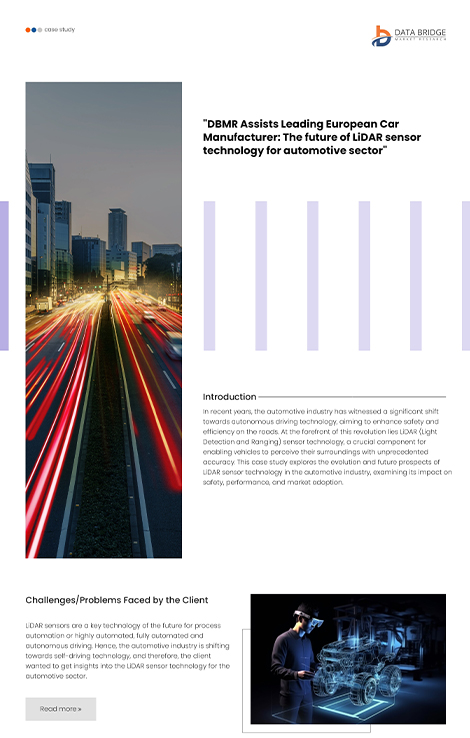Introduction
In recent years, the automotive industry has witnessed a significant shift towards autonomous driving technology, aiming to enhance safety and efficiency on the roads. At the forefront of this revolution lies LiDAR (Light Detection and Ranging) sensor technology, a crucial component for enabling vehicles to perceive their surroundings with unprecedented accuracy. This case study explores the evolution and future prospects of LiDAR sensor technology in the automotive industry, examining its impact on safety,
Challenges/Problems Faced by the Client
LiDAR sensors are a key technology of the future for process automation or highly automated, fully automated and autonomous driving. Hence, the automotive industry is shifting towards self-driving technology, and therefore, the client wanted to get insights into the LiDAR sensor technology for the automotive sector.
- Limited Market Understanding
The client lacked comprehensive knowledge of the diverse markets for LiDAR sensor technology across European countries. Understanding local consumer behavior, regulatory environments, adoption rate of LiDAR and market dynamics was essential for successful implementation of LiDAR sensor technology for the automotive sector.
The LiDAR sensor technology for the automotive industry is likely to be highly competitive across Europe, with numerous players vying for market share. Identifying and analyzing competitors, their strategies, and market positioning was crucial for the client to differentiate themselves and effectively penetrate the market.
- VAT Agency Services for International Transporters in EU Countries
Despite the increasing demand for administrative solutions and services such as VAT refund, excise duty refund, and road solutions among international transporters in EU countries, the client felt that there was a lack of comprehensive understanding regarding the presence and efficacy of VAT agencies in providing these services. The client wanted to improve this knowledge gap, which hampers the efficiency and competitiveness of international transportation LiDAR sensor businesses operating within the EU.
- Maintaining and Improving the System
Most LiDAR systems aren’t designed to handle over-the-air updates and improvements. Besides, most of them are not compatible with models from different generations, even if they are from the same manufacturer. While this was acceptable in the early phase of prototyped LiDAR technology, however the client believed that it could pose compatibility problems with large-scale professional deployments. When an application can’t be performed by a single sensor, integrators and developers must merge data that originates from several of them to avoid the issue.
- Combining Multiple LiDAR and Other Sensors
LiDAR data occasionally needs to be integrated with images from cameras, radar, and other sensors, which necessitates dealing with calibration, synchronization, and other networking complexities and delays the development of the real application. Therefore, the client wanted to understand the complexity of the technology from several manufacturers to handle sensors integrated issues for any automotive operations
The client wanted to establish credibility and trust among potential users and partners, which may be challenging, particularly in regions where people may be less familiar with LiDAR sensor technology or where there are existing dominant players. Providing evidence of successful implementations, testimonials, and building strong partnerships can help the client address credibility concerns.
